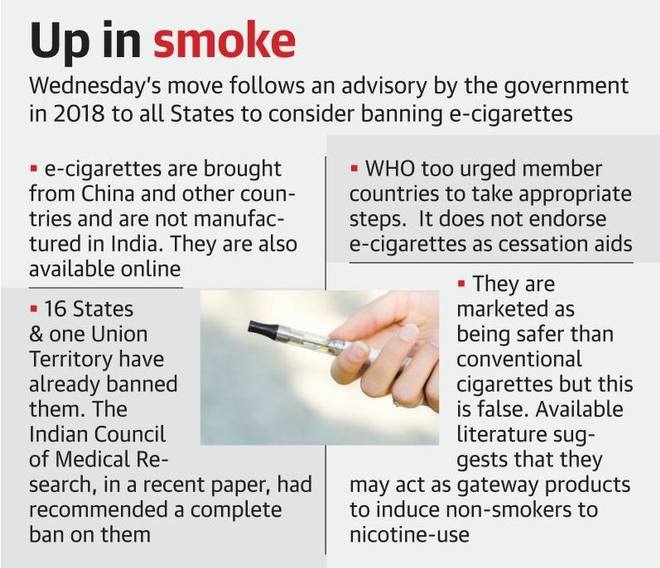
Insights into Editorial: Why has India banned e-cigarettes?
Context:
The Union Cabinet approved the promulgation of the Prohibition of Electronic Cigarettes (production, manufacture, import, export, transport, sale, distribution, storage and advertisement) Ordinance, 2019 with immediate effect.
As a result, anyone violating it will be imprisoned for up to one year or fined up to Rs.1,00,000 or both for the first offence.
Storage of electronic-cigarettes shall also be punishable. Besides health concerns, the government is concerned that e-cigarettes can “seriously undermine and derail the government’s efforts to reduce the prevalence of tobacco use”.
The ordinance will need to be approved by Parliament when it meets in November.
About E-CIGARETTE:
E-cigarettes are the most common form of Electronic Nicotine Delivery Systems (ENDS). These are basically devices that do not burn or use tobacco leaves.
Instead, they vaporise a solution using a battery. This vapour is then inhaled by the user.
E-liquid is composed of five ingredients: vegetable glycerin (a material used in all types of food and personal care products, like toothpaste) and propylene glycol (a solvent most commonly used in fog machines.)
Propylene glycol is the ingredient that produces thicker clouds of vapor.
The World Health Organisation says, adding that these solutions and emissions also contain some solutions that are considered to be “toxicants”.
In terms of shape and size, most e-cigarettes resemble ordinary cigarettes, cigars and smoking pipes, but of late brands have started experimenting with newer designs that may resemble whistles, pens etc.
The U.S. Food and Drug Administration (FDA) has not approved e- cigarettes as an alternative to reduce smoking.
One study found that though e-cigarettes led to higher percentage of people quitting smoking, nearly 80% of quitters were still vaping.
Are e-cigarettes addictive?
- According to a National Youth Tobacco Survey, 2018 carried out by Centers for Disease Control and Prevention (CDC), over 6 million kids in the U.S. are using e-cigarettes.
- A 2015 survey cited by The Truth Initiative (an anti-tobacco organisation) found that almost 60% of those who used e-cigarettes also smoked cigarettes, called as dual users.
- A meta-analysis of 25 studies found that smokers who used e-cigarettes as a cessation aid were 27% less likely to quit smoking.
- High school students in the U.S. who used e-cigarettes at least once in 30 days increased from 11.7% in 2017 to 20.8% in 2018; the increase was 48% for middle school children.
- Flavours in e-cigarettes have been cited as one of the top three reasons for children to use them.
- The misconception that “e-cigarettes are less harmful than other forms of tobacco such as cigarettes” is another main reason. Youth who use e-cigarettes may be more likely to go on to smoke conventional cigarettes.
Important Reasons for Banning:
The total economic cost attributable to tobacco use for all diseases in 2011 amounted to Rs 1,04,500 crore, which is equivalent to 1.04% of the GDP.
The disease burden due to tobacco poses enormous and inequitable economic loss to society and also presents a formidable challenge to the country’s health care systems.
The Health ministry listed a number of reasons to justify the ban on e-cigarettes These included:
- Threat to country’s tobacco control efforts
- Hindrance in achieving targets envisaged under Sustainable Development Goals, National Monitoring Framework for Prevention and Control of non-communicable diseases and National Health Policy, 2017
- Overall interest of public health of the youth and pregnant women as well
- Addictive nature of nicotine
- Scant scientific evidence for use of e-cigarettes as effective tobacco cessation aids
- Safety concern of flavours in combination with nicotine
The government also cited Article 47 of the Indian Constitution to justify the ban on e-cigarettes.
Article 47 reads: “Duty of the State to raise the level of nutrition and the standard of living and to improve public health.
The State shall regard the raising of the level of nutrition and the standard of living of its people and the improvement of public health as among its primary duties and, in particular, the State shall endeavour to bring about prohibition of the consumption except for medicinal purposes of intoxicating drinks and of drugs which are injurious to health.”
The Indian Council of Medical Research (ICMR) too had cautioned against the growing use of e-cigarettes citing studies which noted that use of e-cigarettes could have adverse effects on humans, which include DNA damage, carcinogenic, cellular, molecular and immunological toxicity, respiratory, cardiovascular and neurological disorders, and adverse impact on foetal development and pregnancy.
Conclusion:
This decision is a follow up of a 2018 advisory that the central government had sent to all state governments asking them to consider banning e-cigarettes.
Prior to this announcement, 15 states and one Union territory had already banned e-cigarettes.
These include: Punjab, Karnataka, Mizoram, Kerala, Jammu & Kashmir, Uttar Pradesh, Bihar, Maharashtra, Tamil Nadu, Jharkhand, Himachal Pradesh, Puducherry, Rajasthan, Meghalaya, Odisha and Nagaland.
The government said the decision to ban e-cigarettes is aimed at protecting the youth, the section that is most vulnerable to the health hazards of e-cigarettes.
These variety of e-cigarette products come with attractive appearances and multiple flavours and their use has increased exponentially and has acquired epidemic proportions in developed countries, especially among youth and children.
It said the ban on e-cigarettes will help “protect population, especially the youth and children, from the risk of addiction through e-cigarettes”.